Environmental and Sustainable Design for a Residential Building
VerifiedAdded on 2020/03/23
|12
|3338
|62
Report
AI Summary
This report presents a sustainable management plan for a two-story residential building with an open roof slab. The plan focuses on reducing carbon emissions through strategies like improved indoor environmental quality, energy efficiency, and urban ecology. It addresses minimum resource consumption by considering building materials, transport, and water resources. Furthermore, the plan outlines waste generation and management strategies, including innovation and stormwater management. The report emphasizes the importance of sustainable design principles to minimize environmental impact, conserve resources, and promote responsible waste management practices. The objective is to create a building with minimal carbon emissions, resource consumption, and waste generation, promoting a design that maximizes resource utility and minimizes wastage. The plan considers various sustainable practices such as using daylight, natural ventilation, and ergonomic furniture to improve indoor environmental quality and reduce energy consumption. It also highlights the significance of using environmentally friendly building materials, promoting sustainable transport, and implementing efficient water resource management. The overall aim is to create a sustainable and environmentally friendly residential building.
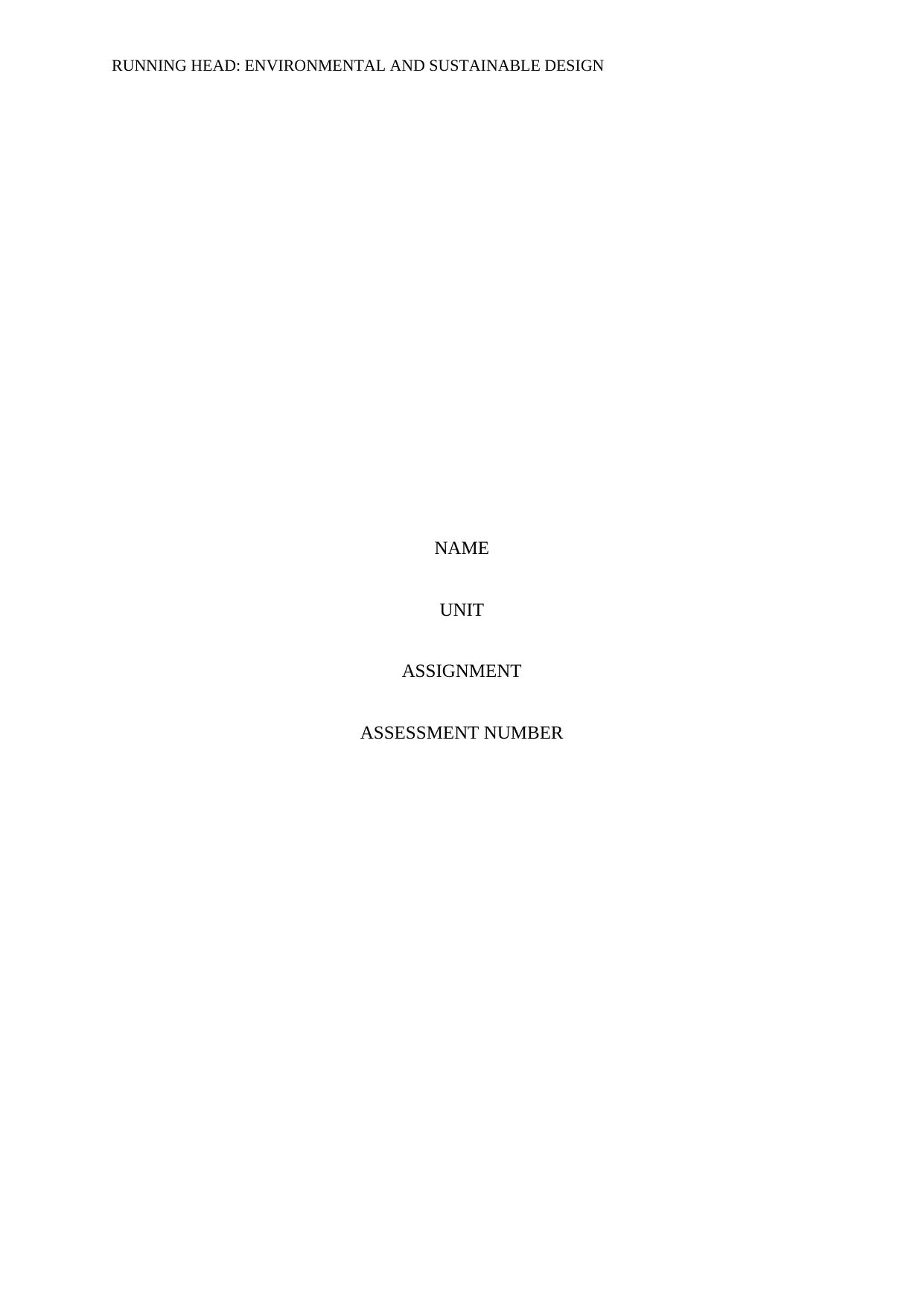
RUNNING HEAD: ENVIRONMENTAL AND SUSTAINABLE DESIGN
NAME
UNIT
ASSIGNMENT
ASSESSMENT NUMBER
NAME
UNIT
ASSIGNMENT
ASSESSMENT NUMBER
Paraphrase This Document
Need a fresh take? Get an instant paraphrase of this document with our AI Paraphraser
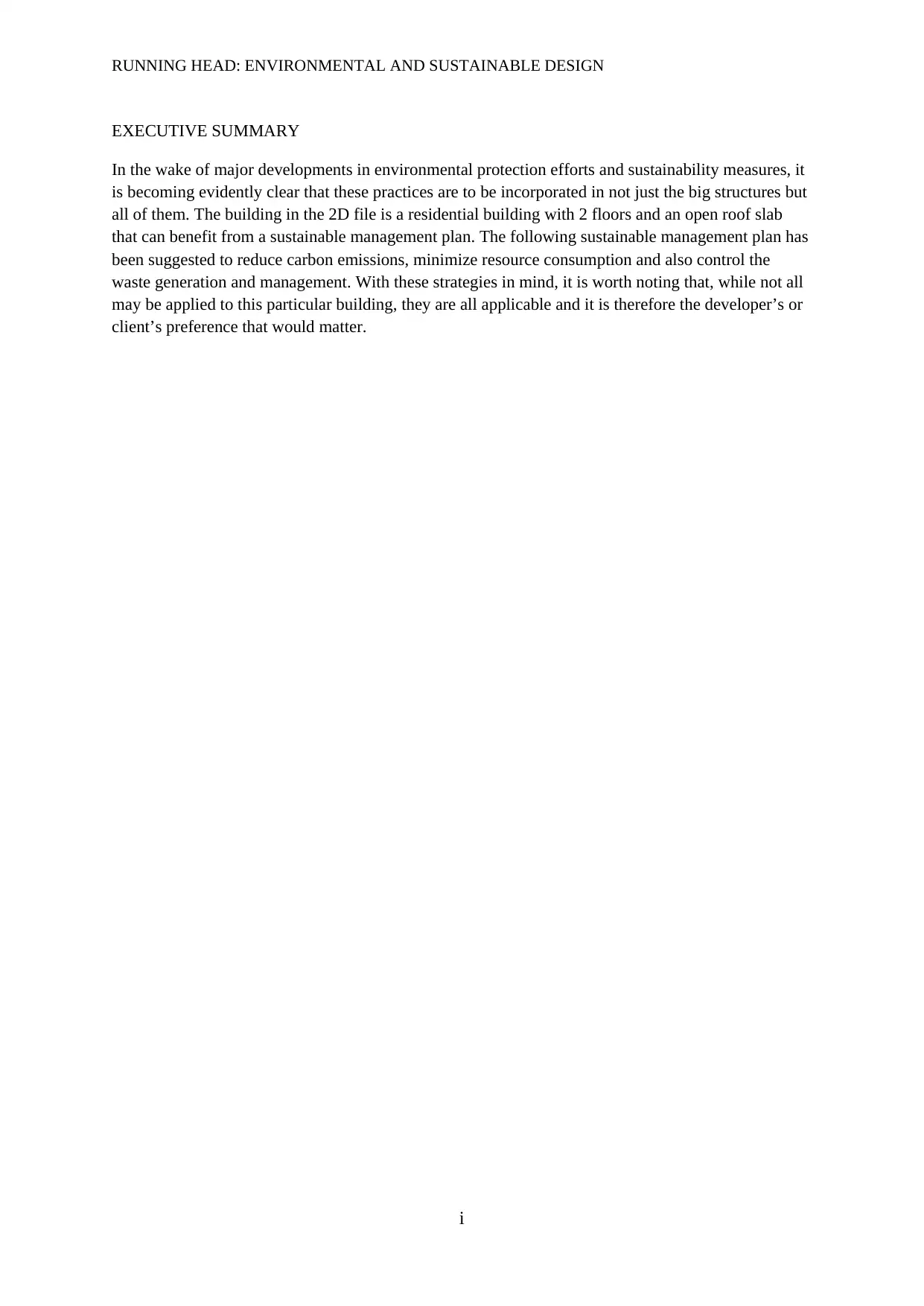
RUNNING HEAD: ENVIRONMENTAL AND SUSTAINABLE DESIGN
EXECUTIVE SUMMARY
In the wake of major developments in environmental protection efforts and sustainability measures, it
is becoming evidently clear that these practices are to be incorporated in not just the big structures but
all of them. The building in the 2D file is a residential building with 2 floors and an open roof slab
that can benefit from a sustainable management plan. The following sustainable management plan has
been suggested to reduce carbon emissions, minimize resource consumption and also control the
waste generation and management. With these strategies in mind, it is worth noting that, while not all
may be applied to this particular building, they are all applicable and it is therefore the developer’s or
client’s preference that would matter.
i
EXECUTIVE SUMMARY
In the wake of major developments in environmental protection efforts and sustainability measures, it
is becoming evidently clear that these practices are to be incorporated in not just the big structures but
all of them. The building in the 2D file is a residential building with 2 floors and an open roof slab
that can benefit from a sustainable management plan. The following sustainable management plan has
been suggested to reduce carbon emissions, minimize resource consumption and also control the
waste generation and management. With these strategies in mind, it is worth noting that, while not all
may be applied to this particular building, they are all applicable and it is therefore the developer’s or
client’s preference that would matter.
i
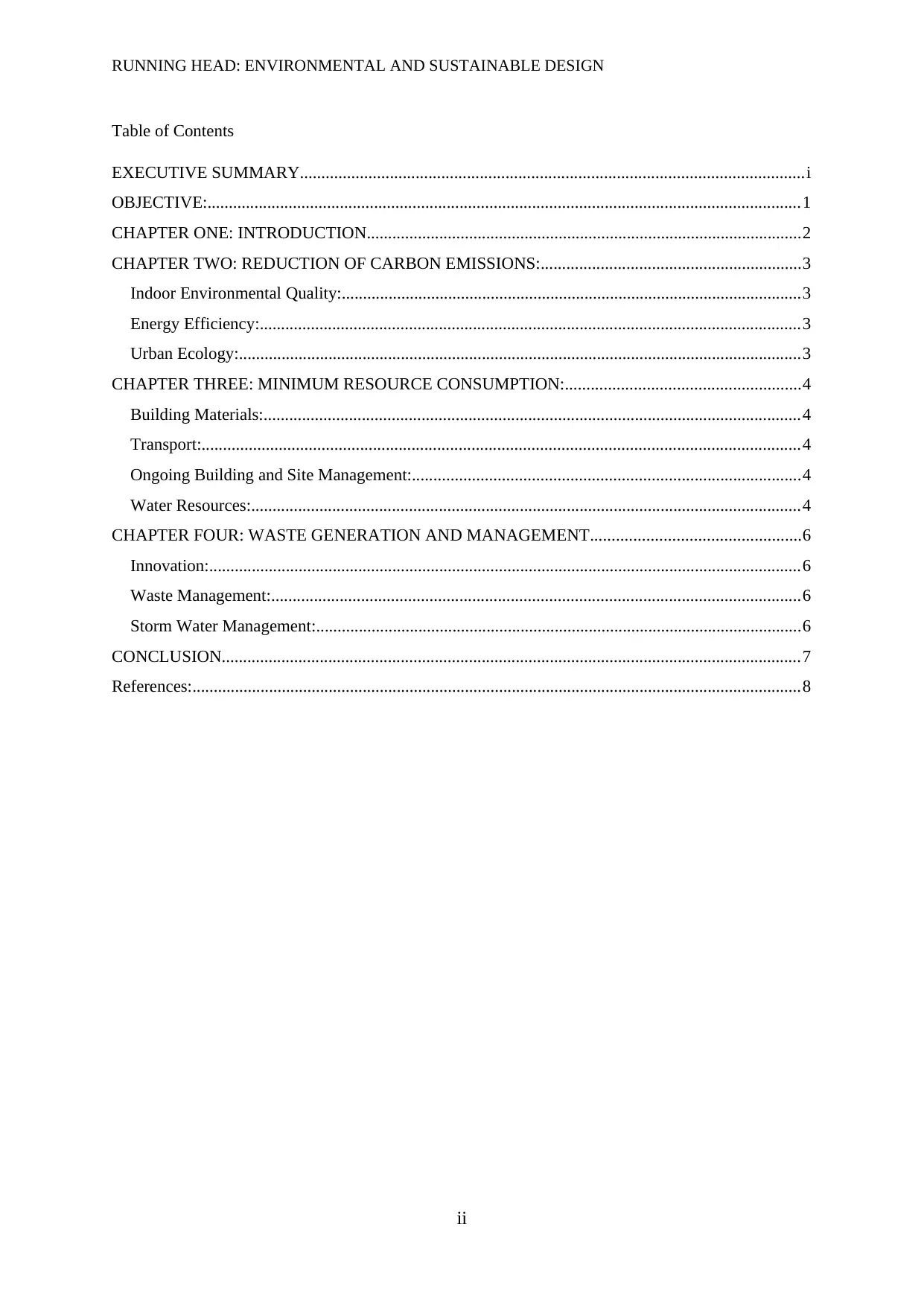
RUNNING HEAD: ENVIRONMENTAL AND SUSTAINABLE DESIGN
Table of Contents
EXECUTIVE SUMMARY......................................................................................................................i
OBJECTIVE:...........................................................................................................................................1
CHAPTER ONE: INTRODUCTION......................................................................................................2
CHAPTER TWO: REDUCTION OF CARBON EMISSIONS:.............................................................3
Indoor Environmental Quality:............................................................................................................3
Energy Efficiency:...............................................................................................................................3
Urban Ecology:....................................................................................................................................3
CHAPTER THREE: MINIMUM RESOURCE CONSUMPTION:.......................................................4
Building Materials:..............................................................................................................................4
Transport:............................................................................................................................................4
Ongoing Building and Site Management:...........................................................................................4
Water Resources:.................................................................................................................................4
CHAPTER FOUR: WASTE GENERATION AND MANAGEMENT.................................................6
Innovation:...........................................................................................................................................6
Waste Management:............................................................................................................................6
Storm Water Management:..................................................................................................................6
CONCLUSION........................................................................................................................................7
References:...............................................................................................................................................8
ii
Table of Contents
EXECUTIVE SUMMARY......................................................................................................................i
OBJECTIVE:...........................................................................................................................................1
CHAPTER ONE: INTRODUCTION......................................................................................................2
CHAPTER TWO: REDUCTION OF CARBON EMISSIONS:.............................................................3
Indoor Environmental Quality:............................................................................................................3
Energy Efficiency:...............................................................................................................................3
Urban Ecology:....................................................................................................................................3
CHAPTER THREE: MINIMUM RESOURCE CONSUMPTION:.......................................................4
Building Materials:..............................................................................................................................4
Transport:............................................................................................................................................4
Ongoing Building and Site Management:...........................................................................................4
Water Resources:.................................................................................................................................4
CHAPTER FOUR: WASTE GENERATION AND MANAGEMENT.................................................6
Innovation:...........................................................................................................................................6
Waste Management:............................................................................................................................6
Storm Water Management:..................................................................................................................6
CONCLUSION........................................................................................................................................7
References:...............................................................................................................................................8
ii
⊘ This is a preview!⊘
Do you want full access?
Subscribe today to unlock all pages.

Trusted by 1+ million students worldwide
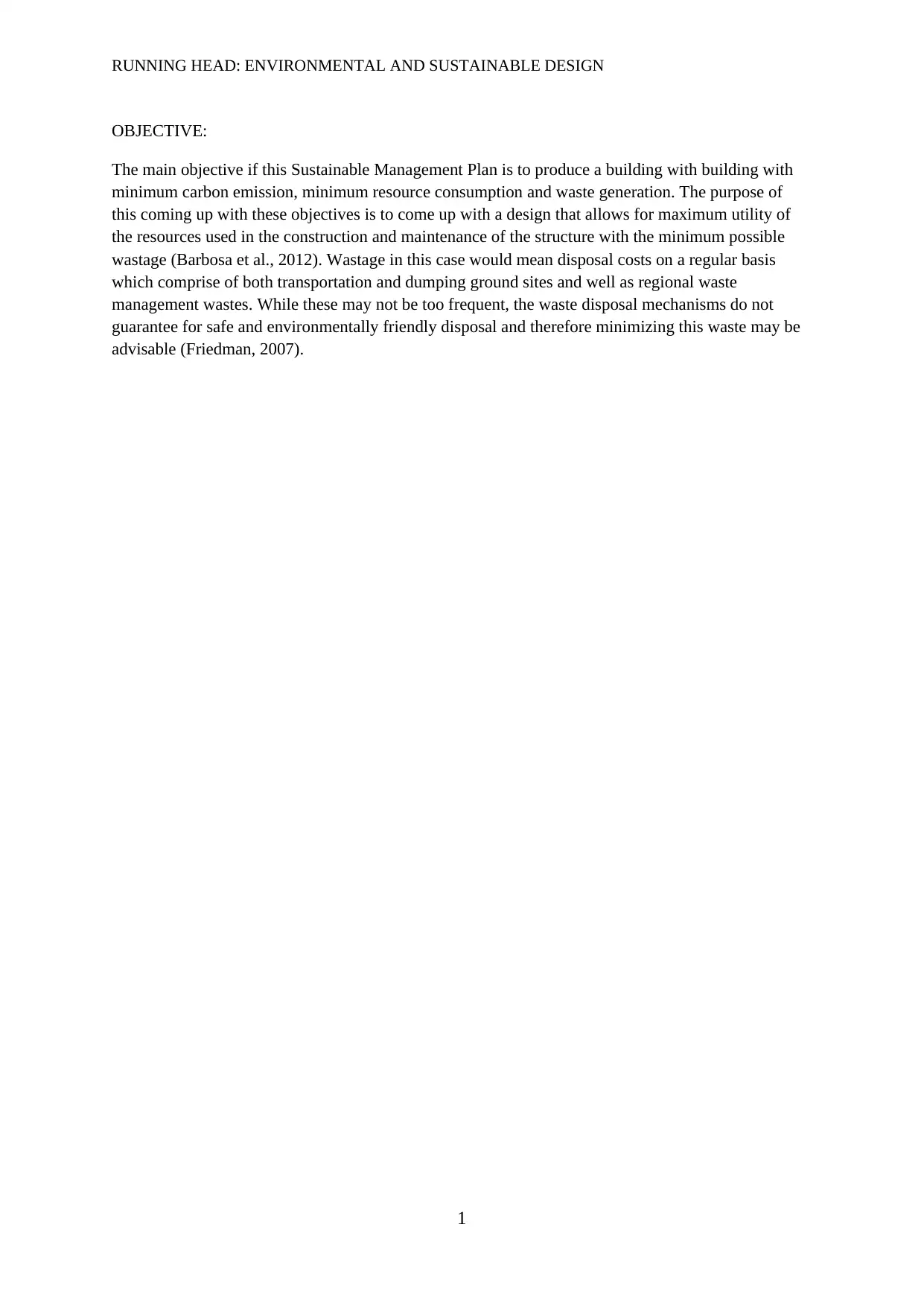
RUNNING HEAD: ENVIRONMENTAL AND SUSTAINABLE DESIGN
OBJECTIVE:
The main objective if this Sustainable Management Plan is to produce a building with building with
minimum carbon emission, minimum resource consumption and waste generation. The purpose of
this coming up with these objectives is to come up with a design that allows for maximum utility of
the resources used in the construction and maintenance of the structure with the minimum possible
wastage (Barbosa et al., 2012). Wastage in this case would mean disposal costs on a regular basis
which comprise of both transportation and dumping ground sites and well as regional waste
management wastes. While these may not be too frequent, the waste disposal mechanisms do not
guarantee for safe and environmentally friendly disposal and therefore minimizing this waste may be
advisable (Friedman, 2007).
1
OBJECTIVE:
The main objective if this Sustainable Management Plan is to produce a building with building with
minimum carbon emission, minimum resource consumption and waste generation. The purpose of
this coming up with these objectives is to come up with a design that allows for maximum utility of
the resources used in the construction and maintenance of the structure with the minimum possible
wastage (Barbosa et al., 2012). Wastage in this case would mean disposal costs on a regular basis
which comprise of both transportation and dumping ground sites and well as regional waste
management wastes. While these may not be too frequent, the waste disposal mechanisms do not
guarantee for safe and environmentally friendly disposal and therefore minimizing this waste may be
advisable (Friedman, 2007).
1
Paraphrase This Document
Need a fresh take? Get an instant paraphrase of this document with our AI Paraphraser
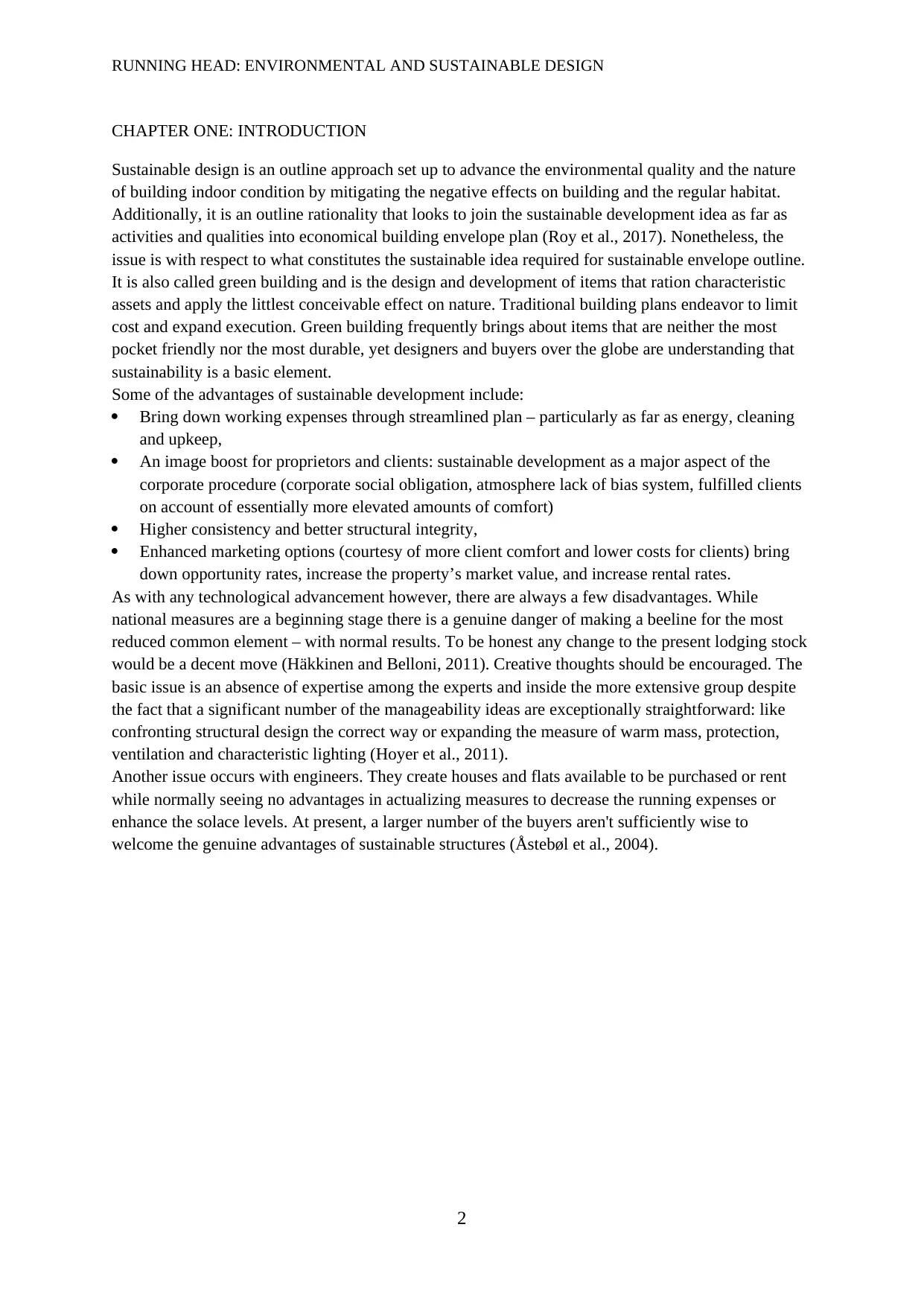
RUNNING HEAD: ENVIRONMENTAL AND SUSTAINABLE DESIGN
CHAPTER ONE: INTRODUCTION
Sustainable design is an outline approach set up to advance the environmental quality and the nature
of building indoor condition by mitigating the negative effects on building and the regular habitat.
Additionally, it is an outline rationality that looks to join the sustainable development idea as far as
activities and qualities into economical building envelope plan (Roy et al., 2017). Nonetheless, the
issue is with respect to what constitutes the sustainable idea required for sustainable envelope outline.
It is also called green building and is the design and development of items that ration characteristic
assets and apply the littlest conceivable effect on nature. Traditional building plans endeavor to limit
cost and expand execution. Green building frequently brings about items that are neither the most
pocket friendly nor the most durable, yet designers and buyers over the globe are understanding that
sustainability is a basic element.
Some of the advantages of sustainable development include:
Bring down working expenses through streamlined plan – particularly as far as energy, cleaning
and upkeep,
An image boost for proprietors and clients: sustainable development as a major aspect of the
corporate procedure (corporate social obligation, atmosphere lack of bias system, fulfilled clients
on account of essentially more elevated amounts of comfort)
Higher consistency and better structural integrity,
Enhanced marketing options (courtesy of more client comfort and lower costs for clients) bring
down opportunity rates, increase the property’s market value, and increase rental rates.
As with any technological advancement however, there are always a few disadvantages. While
national measures are a beginning stage there is a genuine danger of making a beeline for the most
reduced common element – with normal results. To be honest any change to the present lodging stock
would be a decent move (Häkkinen and Belloni, 2011). Creative thoughts should be encouraged. The
basic issue is an absence of expertise among the experts and inside the more extensive group despite
the fact that a significant number of the manageability ideas are exceptionally straightforward: like
confronting structural design the correct way or expanding the measure of warm mass, protection,
ventilation and characteristic lighting (Hoyer et al., 2011).
Another issue occurs with engineers. They create houses and flats available to be purchased or rent
while normally seeing no advantages in actualizing measures to decrease the running expenses or
enhance the solace levels. At present, a larger number of the buyers aren't sufficiently wise to
welcome the genuine advantages of sustainable structures (Åstebøl et al., 2004).
2
CHAPTER ONE: INTRODUCTION
Sustainable design is an outline approach set up to advance the environmental quality and the nature
of building indoor condition by mitigating the negative effects on building and the regular habitat.
Additionally, it is an outline rationality that looks to join the sustainable development idea as far as
activities and qualities into economical building envelope plan (Roy et al., 2017). Nonetheless, the
issue is with respect to what constitutes the sustainable idea required for sustainable envelope outline.
It is also called green building and is the design and development of items that ration characteristic
assets and apply the littlest conceivable effect on nature. Traditional building plans endeavor to limit
cost and expand execution. Green building frequently brings about items that are neither the most
pocket friendly nor the most durable, yet designers and buyers over the globe are understanding that
sustainability is a basic element.
Some of the advantages of sustainable development include:
Bring down working expenses through streamlined plan – particularly as far as energy, cleaning
and upkeep,
An image boost for proprietors and clients: sustainable development as a major aspect of the
corporate procedure (corporate social obligation, atmosphere lack of bias system, fulfilled clients
on account of essentially more elevated amounts of comfort)
Higher consistency and better structural integrity,
Enhanced marketing options (courtesy of more client comfort and lower costs for clients) bring
down opportunity rates, increase the property’s market value, and increase rental rates.
As with any technological advancement however, there are always a few disadvantages. While
national measures are a beginning stage there is a genuine danger of making a beeline for the most
reduced common element – with normal results. To be honest any change to the present lodging stock
would be a decent move (Häkkinen and Belloni, 2011). Creative thoughts should be encouraged. The
basic issue is an absence of expertise among the experts and inside the more extensive group despite
the fact that a significant number of the manageability ideas are exceptionally straightforward: like
confronting structural design the correct way or expanding the measure of warm mass, protection,
ventilation and characteristic lighting (Hoyer et al., 2011).
Another issue occurs with engineers. They create houses and flats available to be purchased or rent
while normally seeing no advantages in actualizing measures to decrease the running expenses or
enhance the solace levels. At present, a larger number of the buyers aren't sufficiently wise to
welcome the genuine advantages of sustainable structures (Åstebøl et al., 2004).
2
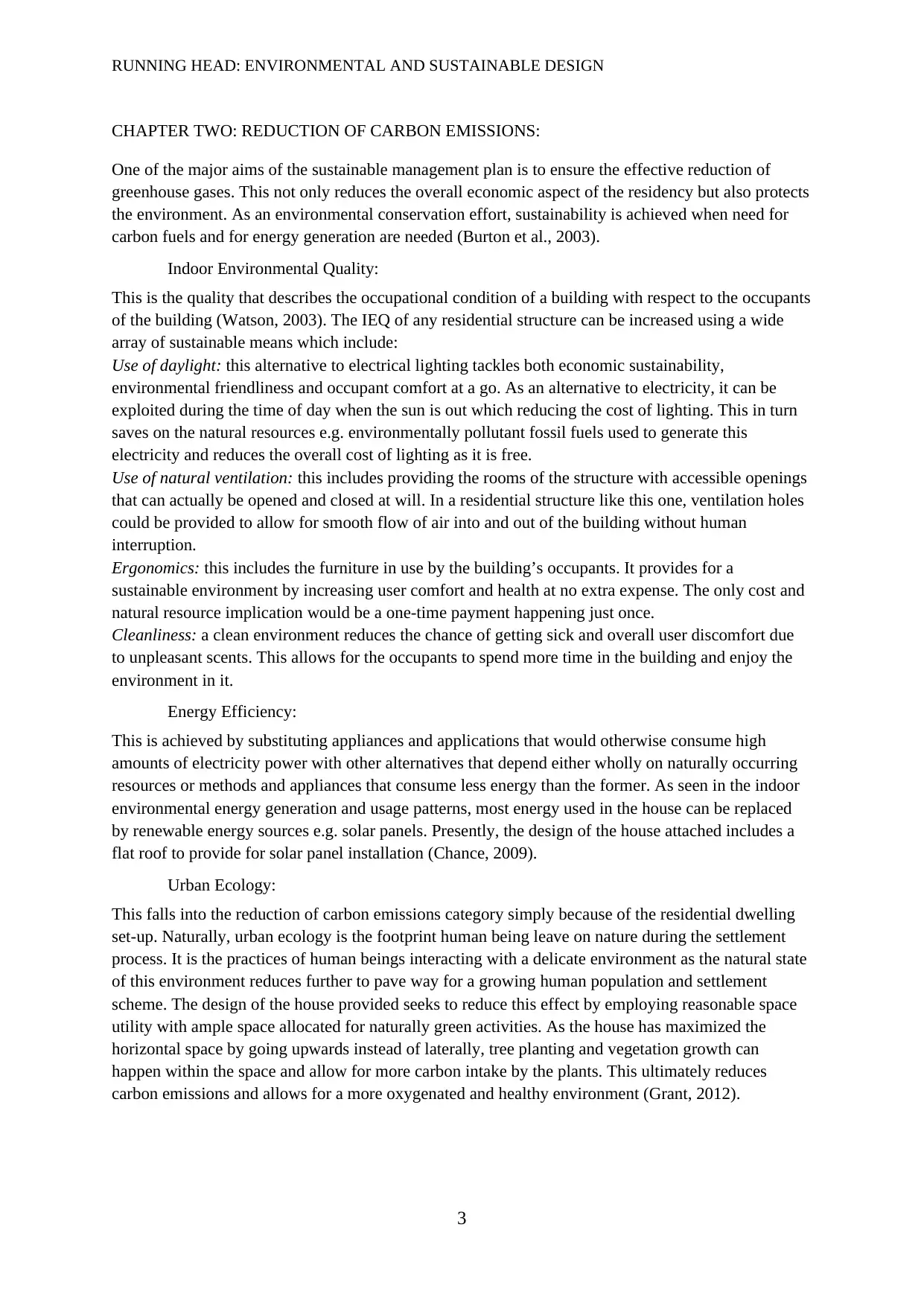
RUNNING HEAD: ENVIRONMENTAL AND SUSTAINABLE DESIGN
CHAPTER TWO: REDUCTION OF CARBON EMISSIONS:
One of the major aims of the sustainable management plan is to ensure the effective reduction of
greenhouse gases. This not only reduces the overall economic aspect of the residency but also protects
the environment. As an environmental conservation effort, sustainability is achieved when need for
carbon fuels and for energy generation are needed (Burton et al., 2003).
Indoor Environmental Quality:
This is the quality that describes the occupational condition of a building with respect to the occupants
of the building (Watson, 2003). The IEQ of any residential structure can be increased using a wide
array of sustainable means which include:
Use of daylight: this alternative to electrical lighting tackles both economic sustainability,
environmental friendliness and occupant comfort at a go. As an alternative to electricity, it can be
exploited during the time of day when the sun is out which reducing the cost of lighting. This in turn
saves on the natural resources e.g. environmentally pollutant fossil fuels used to generate this
electricity and reduces the overall cost of lighting as it is free.
Use of natural ventilation: this includes providing the rooms of the structure with accessible openings
that can actually be opened and closed at will. In a residential structure like this one, ventilation holes
could be provided to allow for smooth flow of air into and out of the building without human
interruption.
Ergonomics: this includes the furniture in use by the building’s occupants. It provides for a
sustainable environment by increasing user comfort and health at no extra expense. The only cost and
natural resource implication would be a one-time payment happening just once.
Cleanliness: a clean environment reduces the chance of getting sick and overall user discomfort due
to unpleasant scents. This allows for the occupants to spend more time in the building and enjoy the
environment in it.
Energy Efficiency:
This is achieved by substituting appliances and applications that would otherwise consume high
amounts of electricity power with other alternatives that depend either wholly on naturally occurring
resources or methods and appliances that consume less energy than the former. As seen in the indoor
environmental energy generation and usage patterns, most energy used in the house can be replaced
by renewable energy sources e.g. solar panels. Presently, the design of the house attached includes a
flat roof to provide for solar panel installation (Chance, 2009).
Urban Ecology:
This falls into the reduction of carbon emissions category simply because of the residential dwelling
set-up. Naturally, urban ecology is the footprint human being leave on nature during the settlement
process. It is the practices of human beings interacting with a delicate environment as the natural state
of this environment reduces further to pave way for a growing human population and settlement
scheme. The design of the house provided seeks to reduce this effect by employing reasonable space
utility with ample space allocated for naturally green activities. As the house has maximized the
horizontal space by going upwards instead of laterally, tree planting and vegetation growth can
happen within the space and allow for more carbon intake by the plants. This ultimately reduces
carbon emissions and allows for a more oxygenated and healthy environment (Grant, 2012).
3
CHAPTER TWO: REDUCTION OF CARBON EMISSIONS:
One of the major aims of the sustainable management plan is to ensure the effective reduction of
greenhouse gases. This not only reduces the overall economic aspect of the residency but also protects
the environment. As an environmental conservation effort, sustainability is achieved when need for
carbon fuels and for energy generation are needed (Burton et al., 2003).
Indoor Environmental Quality:
This is the quality that describes the occupational condition of a building with respect to the occupants
of the building (Watson, 2003). The IEQ of any residential structure can be increased using a wide
array of sustainable means which include:
Use of daylight: this alternative to electrical lighting tackles both economic sustainability,
environmental friendliness and occupant comfort at a go. As an alternative to electricity, it can be
exploited during the time of day when the sun is out which reducing the cost of lighting. This in turn
saves on the natural resources e.g. environmentally pollutant fossil fuels used to generate this
electricity and reduces the overall cost of lighting as it is free.
Use of natural ventilation: this includes providing the rooms of the structure with accessible openings
that can actually be opened and closed at will. In a residential structure like this one, ventilation holes
could be provided to allow for smooth flow of air into and out of the building without human
interruption.
Ergonomics: this includes the furniture in use by the building’s occupants. It provides for a
sustainable environment by increasing user comfort and health at no extra expense. The only cost and
natural resource implication would be a one-time payment happening just once.
Cleanliness: a clean environment reduces the chance of getting sick and overall user discomfort due
to unpleasant scents. This allows for the occupants to spend more time in the building and enjoy the
environment in it.
Energy Efficiency:
This is achieved by substituting appliances and applications that would otherwise consume high
amounts of electricity power with other alternatives that depend either wholly on naturally occurring
resources or methods and appliances that consume less energy than the former. As seen in the indoor
environmental energy generation and usage patterns, most energy used in the house can be replaced
by renewable energy sources e.g. solar panels. Presently, the design of the house attached includes a
flat roof to provide for solar panel installation (Chance, 2009).
Urban Ecology:
This falls into the reduction of carbon emissions category simply because of the residential dwelling
set-up. Naturally, urban ecology is the footprint human being leave on nature during the settlement
process. It is the practices of human beings interacting with a delicate environment as the natural state
of this environment reduces further to pave way for a growing human population and settlement
scheme. The design of the house provided seeks to reduce this effect by employing reasonable space
utility with ample space allocated for naturally green activities. As the house has maximized the
horizontal space by going upwards instead of laterally, tree planting and vegetation growth can
happen within the space and allow for more carbon intake by the plants. This ultimately reduces
carbon emissions and allows for a more oxygenated and healthy environment (Grant, 2012).
3
⊘ This is a preview!⊘
Do you want full access?
Subscribe today to unlock all pages.

Trusted by 1+ million students worldwide
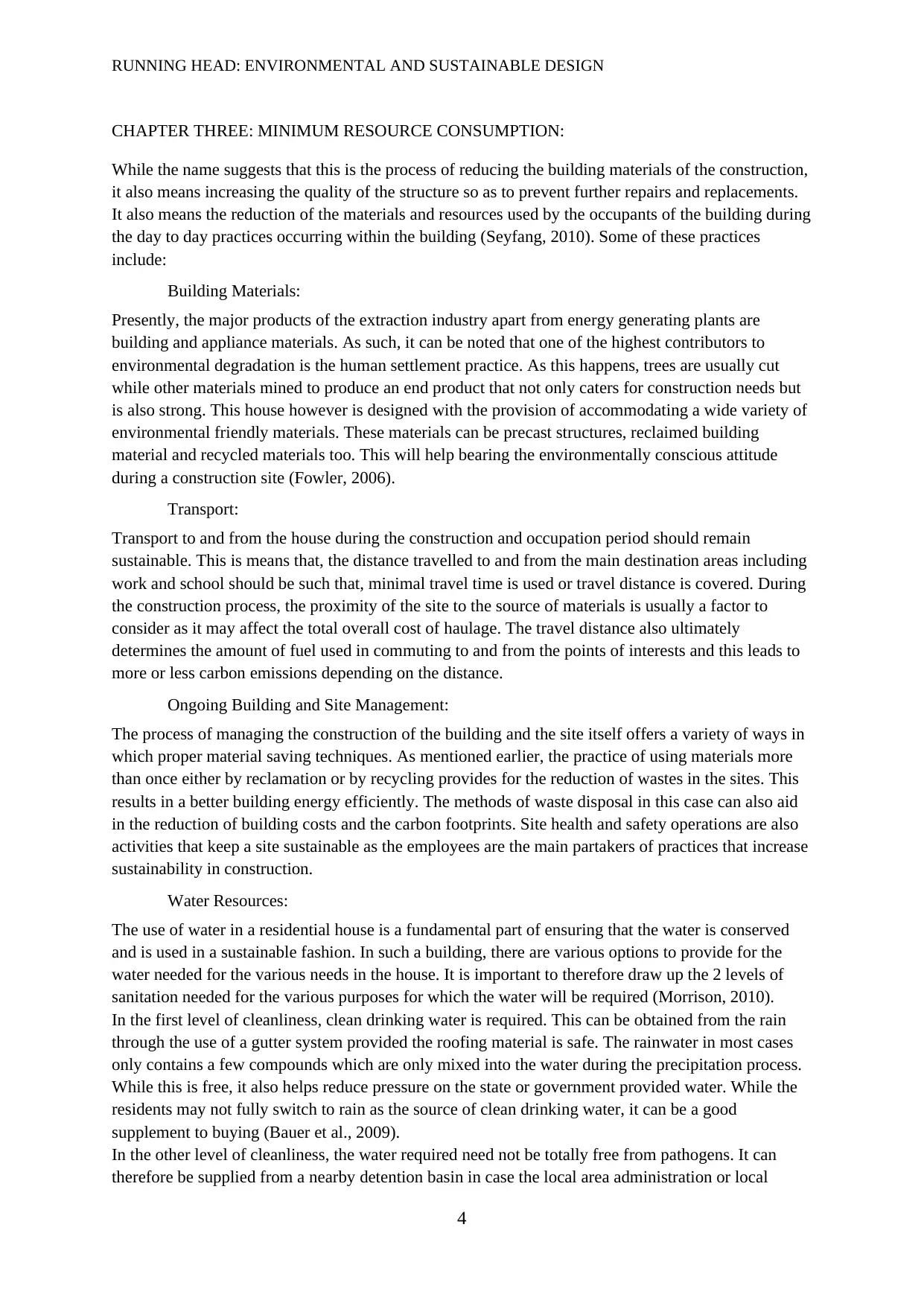
RUNNING HEAD: ENVIRONMENTAL AND SUSTAINABLE DESIGN
CHAPTER THREE: MINIMUM RESOURCE CONSUMPTION:
While the name suggests that this is the process of reducing the building materials of the construction,
it also means increasing the quality of the structure so as to prevent further repairs and replacements.
It also means the reduction of the materials and resources used by the occupants of the building during
the day to day practices occurring within the building (Seyfang, 2010). Some of these practices
include:
Building Materials:
Presently, the major products of the extraction industry apart from energy generating plants are
building and appliance materials. As such, it can be noted that one of the highest contributors to
environmental degradation is the human settlement practice. As this happens, trees are usually cut
while other materials mined to produce an end product that not only caters for construction needs but
is also strong. This house however is designed with the provision of accommodating a wide variety of
environmental friendly materials. These materials can be precast structures, reclaimed building
material and recycled materials too. This will help bearing the environmentally conscious attitude
during a construction site (Fowler, 2006).
Transport:
Transport to and from the house during the construction and occupation period should remain
sustainable. This is means that, the distance travelled to and from the main destination areas including
work and school should be such that, minimal travel time is used or travel distance is covered. During
the construction process, the proximity of the site to the source of materials is usually a factor to
consider as it may affect the total overall cost of haulage. The travel distance also ultimately
determines the amount of fuel used in commuting to and from the points of interests and this leads to
more or less carbon emissions depending on the distance.
Ongoing Building and Site Management:
The process of managing the construction of the building and the site itself offers a variety of ways in
which proper material saving techniques. As mentioned earlier, the practice of using materials more
than once either by reclamation or by recycling provides for the reduction of wastes in the sites. This
results in a better building energy efficiently. The methods of waste disposal in this case can also aid
in the reduction of building costs and the carbon footprints. Site health and safety operations are also
activities that keep a site sustainable as the employees are the main partakers of practices that increase
sustainability in construction.
Water Resources:
The use of water in a residential house is a fundamental part of ensuring that the water is conserved
and is used in a sustainable fashion. In such a building, there are various options to provide for the
water needed for the various needs in the house. It is important to therefore draw up the 2 levels of
sanitation needed for the various purposes for which the water will be required (Morrison, 2010).
In the first level of cleanliness, clean drinking water is required. This can be obtained from the rain
through the use of a gutter system provided the roofing material is safe. The rainwater in most cases
only contains a few compounds which are only mixed into the water during the precipitation process.
While this is free, it also helps reduce pressure on the state or government provided water. While the
residents may not fully switch to rain as the source of clean drinking water, it can be a good
supplement to buying (Bauer et al., 2009).
In the other level of cleanliness, the water required need not be totally free from pathogens. It can
therefore be supplied from a nearby detention basin in case the local area administration or local
4
CHAPTER THREE: MINIMUM RESOURCE CONSUMPTION:
While the name suggests that this is the process of reducing the building materials of the construction,
it also means increasing the quality of the structure so as to prevent further repairs and replacements.
It also means the reduction of the materials and resources used by the occupants of the building during
the day to day practices occurring within the building (Seyfang, 2010). Some of these practices
include:
Building Materials:
Presently, the major products of the extraction industry apart from energy generating plants are
building and appliance materials. As such, it can be noted that one of the highest contributors to
environmental degradation is the human settlement practice. As this happens, trees are usually cut
while other materials mined to produce an end product that not only caters for construction needs but
is also strong. This house however is designed with the provision of accommodating a wide variety of
environmental friendly materials. These materials can be precast structures, reclaimed building
material and recycled materials too. This will help bearing the environmentally conscious attitude
during a construction site (Fowler, 2006).
Transport:
Transport to and from the house during the construction and occupation period should remain
sustainable. This is means that, the distance travelled to and from the main destination areas including
work and school should be such that, minimal travel time is used or travel distance is covered. During
the construction process, the proximity of the site to the source of materials is usually a factor to
consider as it may affect the total overall cost of haulage. The travel distance also ultimately
determines the amount of fuel used in commuting to and from the points of interests and this leads to
more or less carbon emissions depending on the distance.
Ongoing Building and Site Management:
The process of managing the construction of the building and the site itself offers a variety of ways in
which proper material saving techniques. As mentioned earlier, the practice of using materials more
than once either by reclamation or by recycling provides for the reduction of wastes in the sites. This
results in a better building energy efficiently. The methods of waste disposal in this case can also aid
in the reduction of building costs and the carbon footprints. Site health and safety operations are also
activities that keep a site sustainable as the employees are the main partakers of practices that increase
sustainability in construction.
Water Resources:
The use of water in a residential house is a fundamental part of ensuring that the water is conserved
and is used in a sustainable fashion. In such a building, there are various options to provide for the
water needed for the various needs in the house. It is important to therefore draw up the 2 levels of
sanitation needed for the various purposes for which the water will be required (Morrison, 2010).
In the first level of cleanliness, clean drinking water is required. This can be obtained from the rain
through the use of a gutter system provided the roofing material is safe. The rainwater in most cases
only contains a few compounds which are only mixed into the water during the precipitation process.
While this is free, it also helps reduce pressure on the state or government provided water. While the
residents may not fully switch to rain as the source of clean drinking water, it can be a good
supplement to buying (Bauer et al., 2009).
In the other level of cleanliness, the water required need not be totally free from pathogens. It can
therefore be supplied from a nearby detention basin in case the local area administration or local
4
Paraphrase This Document
Need a fresh take? Get an instant paraphrase of this document with our AI Paraphraser
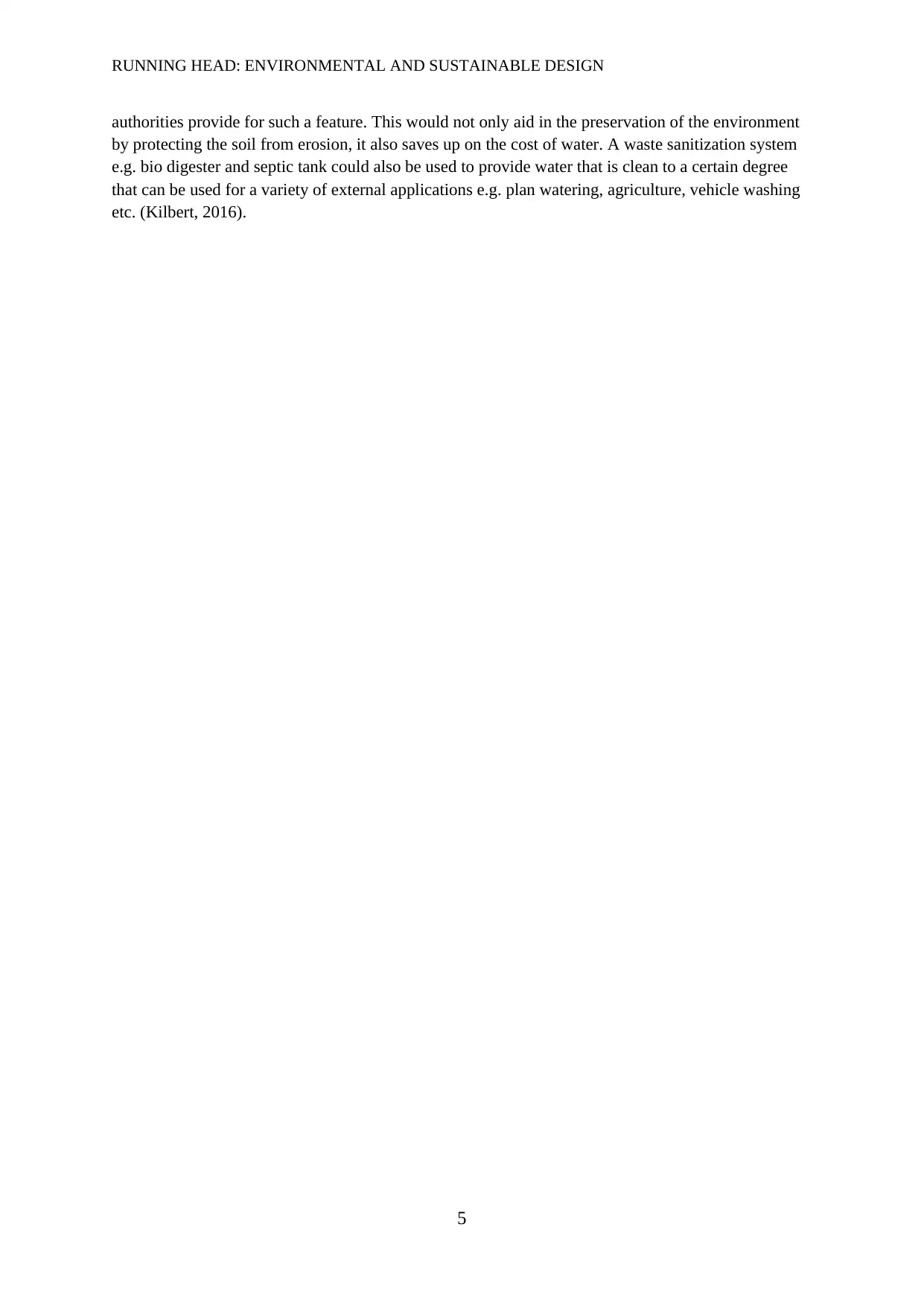
RUNNING HEAD: ENVIRONMENTAL AND SUSTAINABLE DESIGN
authorities provide for such a feature. This would not only aid in the preservation of the environment
by protecting the soil from erosion, it also saves up on the cost of water. A waste sanitization system
e.g. bio digester and septic tank could also be used to provide water that is clean to a certain degree
that can be used for a variety of external applications e.g. plan watering, agriculture, vehicle washing
etc. (Kilbert, 2016).
5
authorities provide for such a feature. This would not only aid in the preservation of the environment
by protecting the soil from erosion, it also saves up on the cost of water. A waste sanitization system
e.g. bio digester and septic tank could also be used to provide water that is clean to a certain degree
that can be used for a variety of external applications e.g. plan watering, agriculture, vehicle washing
etc. (Kilbert, 2016).
5
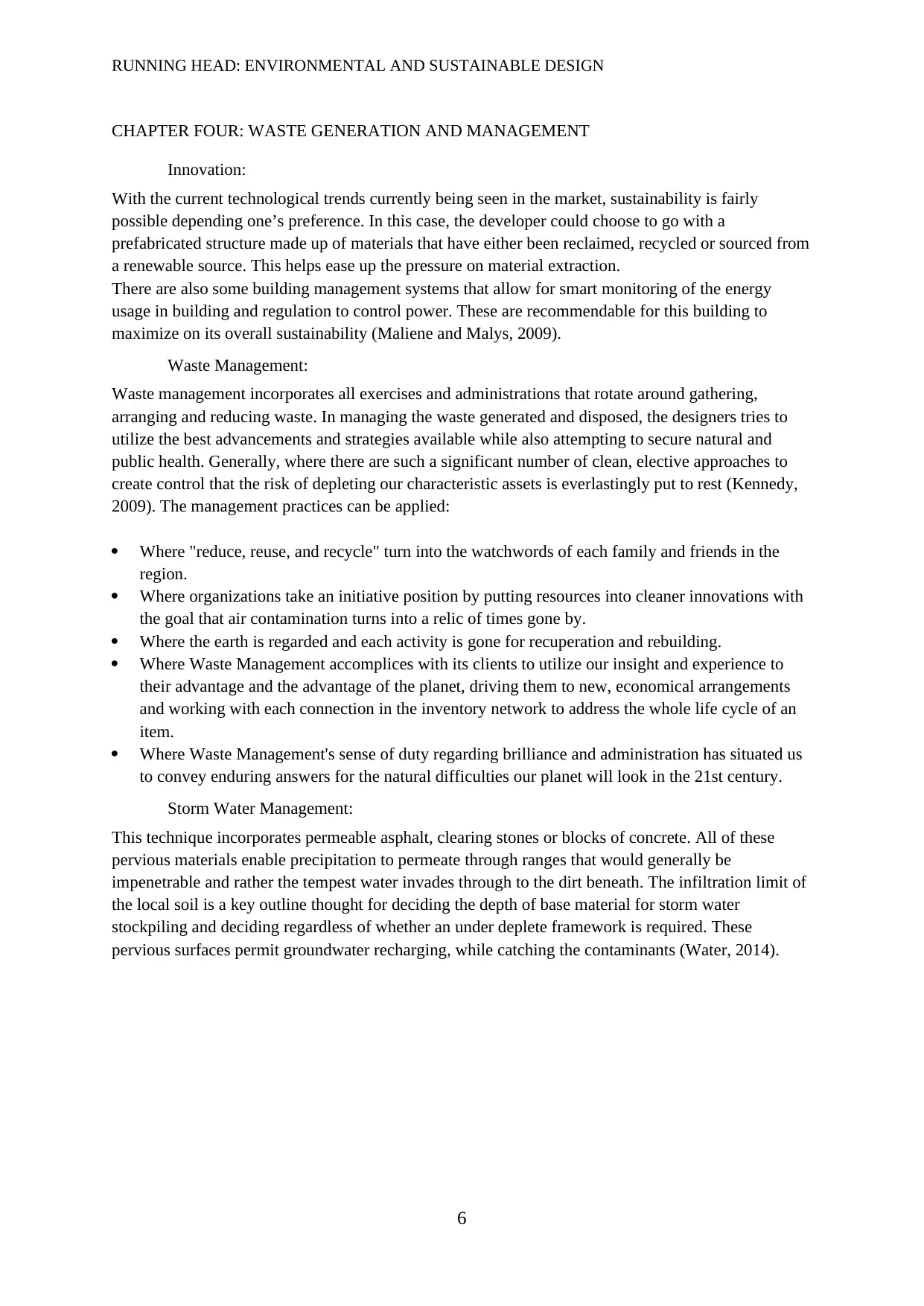
RUNNING HEAD: ENVIRONMENTAL AND SUSTAINABLE DESIGN
CHAPTER FOUR: WASTE GENERATION AND MANAGEMENT
Innovation:
With the current technological trends currently being seen in the market, sustainability is fairly
possible depending one’s preference. In this case, the developer could choose to go with a
prefabricated structure made up of materials that have either been reclaimed, recycled or sourced from
a renewable source. This helps ease up the pressure on material extraction.
There are also some building management systems that allow for smart monitoring of the energy
usage in building and regulation to control power. These are recommendable for this building to
maximize on its overall sustainability (Maliene and Malys, 2009).
Waste Management:
Waste management incorporates all exercises and administrations that rotate around gathering,
arranging and reducing waste. In managing the waste generated and disposed, the designers tries to
utilize the best advancements and strategies available while also attempting to secure natural and
public health. Generally, where there are such a significant number of clean, elective approaches to
create control that the risk of depleting our characteristic assets is everlastingly put to rest (Kennedy,
2009). The management practices can be applied:
Where "reduce, reuse, and recycle" turn into the watchwords of each family and friends in the
region.
Where organizations take an initiative position by putting resources into cleaner innovations with
the goal that air contamination turns into a relic of times gone by.
Where the earth is regarded and each activity is gone for recuperation and rebuilding.
Where Waste Management accomplices with its clients to utilize our insight and experience to
their advantage and the advantage of the planet, driving them to new, economical arrangements
and working with each connection in the inventory network to address the whole life cycle of an
item.
Where Waste Management's sense of duty regarding brilliance and administration has situated us
to convey enduring answers for the natural difficulties our planet will look in the 21st century.
Storm Water Management:
This technique incorporates permeable asphalt, clearing stones or blocks of concrete. All of these
pervious materials enable precipitation to permeate through ranges that would generally be
impenetrable and rather the tempest water invades through to the dirt beneath. The infiltration limit of
the local soil is a key outline thought for deciding the depth of base material for storm water
stockpiling and deciding regardless of whether an under deplete framework is required. These
pervious surfaces permit groundwater recharging, while catching the contaminants (Water, 2014).
6
CHAPTER FOUR: WASTE GENERATION AND MANAGEMENT
Innovation:
With the current technological trends currently being seen in the market, sustainability is fairly
possible depending one’s preference. In this case, the developer could choose to go with a
prefabricated structure made up of materials that have either been reclaimed, recycled or sourced from
a renewable source. This helps ease up the pressure on material extraction.
There are also some building management systems that allow for smart monitoring of the energy
usage in building and regulation to control power. These are recommendable for this building to
maximize on its overall sustainability (Maliene and Malys, 2009).
Waste Management:
Waste management incorporates all exercises and administrations that rotate around gathering,
arranging and reducing waste. In managing the waste generated and disposed, the designers tries to
utilize the best advancements and strategies available while also attempting to secure natural and
public health. Generally, where there are such a significant number of clean, elective approaches to
create control that the risk of depleting our characteristic assets is everlastingly put to rest (Kennedy,
2009). The management practices can be applied:
Where "reduce, reuse, and recycle" turn into the watchwords of each family and friends in the
region.
Where organizations take an initiative position by putting resources into cleaner innovations with
the goal that air contamination turns into a relic of times gone by.
Where the earth is regarded and each activity is gone for recuperation and rebuilding.
Where Waste Management accomplices with its clients to utilize our insight and experience to
their advantage and the advantage of the planet, driving them to new, economical arrangements
and working with each connection in the inventory network to address the whole life cycle of an
item.
Where Waste Management's sense of duty regarding brilliance and administration has situated us
to convey enduring answers for the natural difficulties our planet will look in the 21st century.
Storm Water Management:
This technique incorporates permeable asphalt, clearing stones or blocks of concrete. All of these
pervious materials enable precipitation to permeate through ranges that would generally be
impenetrable and rather the tempest water invades through to the dirt beneath. The infiltration limit of
the local soil is a key outline thought for deciding the depth of base material for storm water
stockpiling and deciding regardless of whether an under deplete framework is required. These
pervious surfaces permit groundwater recharging, while catching the contaminants (Water, 2014).
6
⊘ This is a preview!⊘
Do you want full access?
Subscribe today to unlock all pages.

Trusted by 1+ million students worldwide
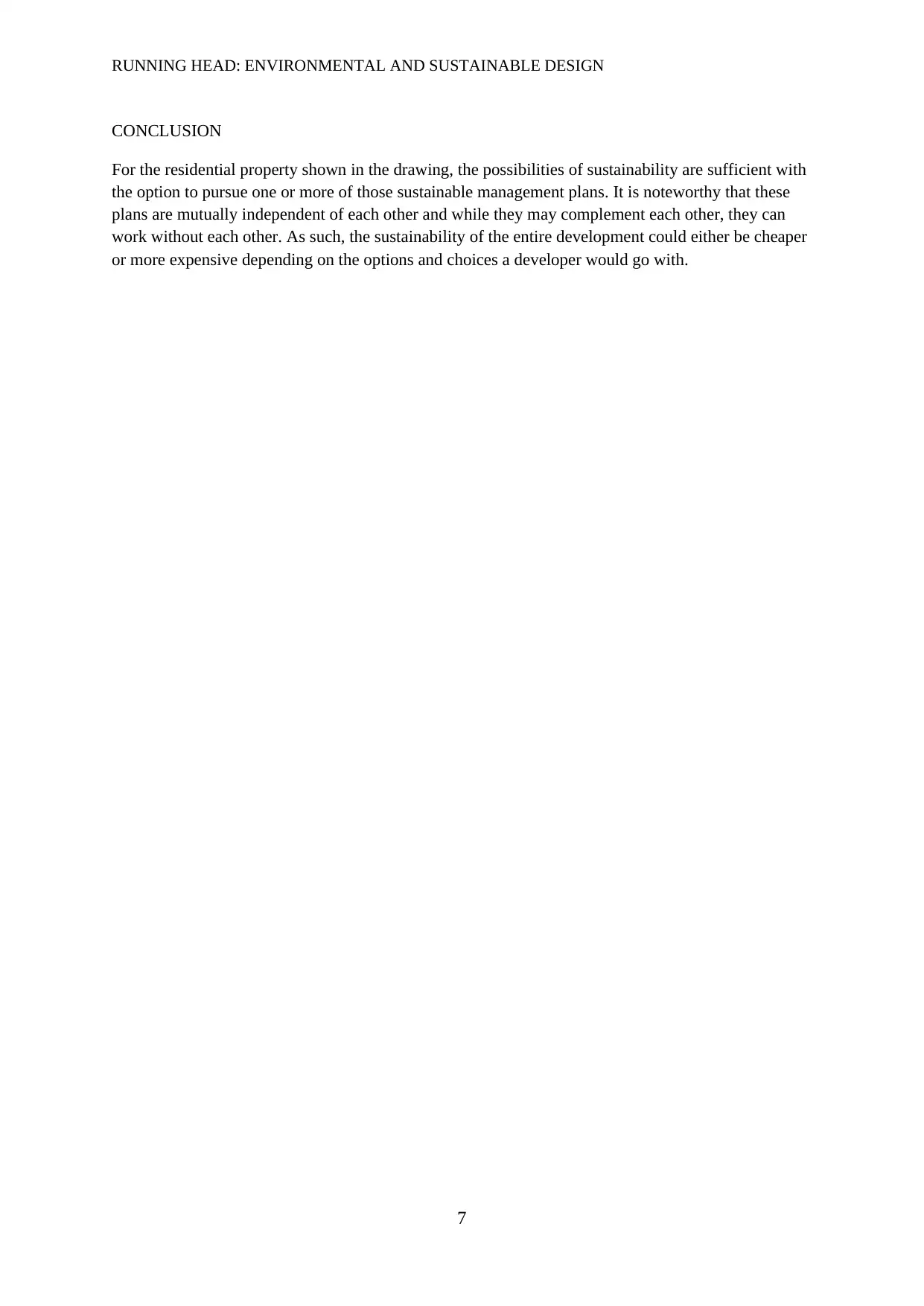
RUNNING HEAD: ENVIRONMENTAL AND SUSTAINABLE DESIGN
CONCLUSION
For the residential property shown in the drawing, the possibilities of sustainability are sufficient with
the option to pursue one or more of those sustainable management plans. It is noteworthy that these
plans are mutually independent of each other and while they may complement each other, they can
work without each other. As such, the sustainability of the entire development could either be cheaper
or more expensive depending on the options and choices a developer would go with.
7
CONCLUSION
For the residential property shown in the drawing, the possibilities of sustainability are sufficient with
the option to pursue one or more of those sustainable management plans. It is noteworthy that these
plans are mutually independent of each other and while they may complement each other, they can
work without each other. As such, the sustainability of the entire development could either be cheaper
or more expensive depending on the options and choices a developer would go with.
7
Paraphrase This Document
Need a fresh take? Get an instant paraphrase of this document with our AI Paraphraser
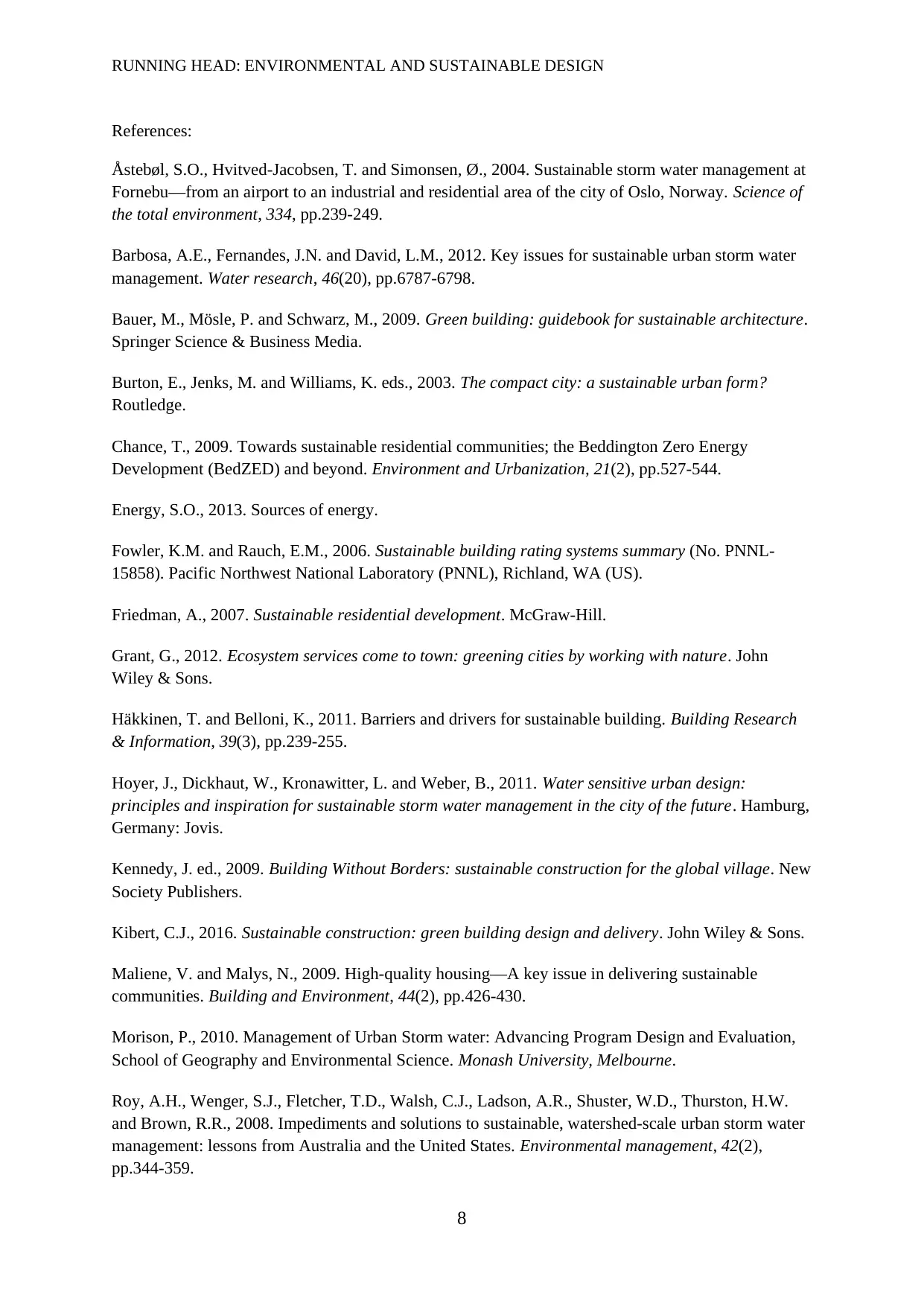
RUNNING HEAD: ENVIRONMENTAL AND SUSTAINABLE DESIGN
References:
Åstebøl, S.O., Hvitved-Jacobsen, T. and Simonsen, Ø., 2004. Sustainable storm water management at
Fornebu—from an airport to an industrial and residential area of the city of Oslo, Norway. Science of
the total environment, 334, pp.239-249.
Barbosa, A.E., Fernandes, J.N. and David, L.M., 2012. Key issues for sustainable urban storm water
management. Water research, 46(20), pp.6787-6798.
Bauer, M., Mösle, P. and Schwarz, M., 2009. Green building: guidebook for sustainable architecture.
Springer Science & Business Media.
Burton, E., Jenks, M. and Williams, K. eds., 2003. The compact city: a sustainable urban form?
Routledge.
Chance, T., 2009. Towards sustainable residential communities; the Beddington Zero Energy
Development (BedZED) and beyond. Environment and Urbanization, 21(2), pp.527-544.
Energy, S.O., 2013. Sources of energy.
Fowler, K.M. and Rauch, E.M., 2006. Sustainable building rating systems summary (No. PNNL-
15858). Pacific Northwest National Laboratory (PNNL), Richland, WA (US).
Friedman, A., 2007. Sustainable residential development. McGraw-Hill.
Grant, G., 2012. Ecosystem services come to town: greening cities by working with nature. John
Wiley & Sons.
Häkkinen, T. and Belloni, K., 2011. Barriers and drivers for sustainable building. Building Research
& Information, 39(3), pp.239-255.
Hoyer, J., Dickhaut, W., Kronawitter, L. and Weber, B., 2011. Water sensitive urban design:
principles and inspiration for sustainable storm water management in the city of the future. Hamburg,
Germany: Jovis.
Kennedy, J. ed., 2009. Building Without Borders: sustainable construction for the global village. New
Society Publishers.
Kibert, C.J., 2016. Sustainable construction: green building design and delivery. John Wiley & Sons.
Maliene, V. and Malys, N., 2009. High-quality housing—A key issue in delivering sustainable
communities. Building and Environment, 44(2), pp.426-430.
Morison, P., 2010. Management of Urban Storm water: Advancing Program Design and Evaluation,
School of Geography and Environmental Science. Monash University, Melbourne.
Roy, A.H., Wenger, S.J., Fletcher, T.D., Walsh, C.J., Ladson, A.R., Shuster, W.D., Thurston, H.W.
and Brown, R.R., 2008. Impediments and solutions to sustainable, watershed-scale urban storm water
management: lessons from Australia and the United States. Environmental management, 42(2),
pp.344-359.
8
References:
Åstebøl, S.O., Hvitved-Jacobsen, T. and Simonsen, Ø., 2004. Sustainable storm water management at
Fornebu—from an airport to an industrial and residential area of the city of Oslo, Norway. Science of
the total environment, 334, pp.239-249.
Barbosa, A.E., Fernandes, J.N. and David, L.M., 2012. Key issues for sustainable urban storm water
management. Water research, 46(20), pp.6787-6798.
Bauer, M., Mösle, P. and Schwarz, M., 2009. Green building: guidebook for sustainable architecture.
Springer Science & Business Media.
Burton, E., Jenks, M. and Williams, K. eds., 2003. The compact city: a sustainable urban form?
Routledge.
Chance, T., 2009. Towards sustainable residential communities; the Beddington Zero Energy
Development (BedZED) and beyond. Environment and Urbanization, 21(2), pp.527-544.
Energy, S.O., 2013. Sources of energy.
Fowler, K.M. and Rauch, E.M., 2006. Sustainable building rating systems summary (No. PNNL-
15858). Pacific Northwest National Laboratory (PNNL), Richland, WA (US).
Friedman, A., 2007. Sustainable residential development. McGraw-Hill.
Grant, G., 2012. Ecosystem services come to town: greening cities by working with nature. John
Wiley & Sons.
Häkkinen, T. and Belloni, K., 2011. Barriers and drivers for sustainable building. Building Research
& Information, 39(3), pp.239-255.
Hoyer, J., Dickhaut, W., Kronawitter, L. and Weber, B., 2011. Water sensitive urban design:
principles and inspiration for sustainable storm water management in the city of the future. Hamburg,
Germany: Jovis.
Kennedy, J. ed., 2009. Building Without Borders: sustainable construction for the global village. New
Society Publishers.
Kibert, C.J., 2016. Sustainable construction: green building design and delivery. John Wiley & Sons.
Maliene, V. and Malys, N., 2009. High-quality housing—A key issue in delivering sustainable
communities. Building and Environment, 44(2), pp.426-430.
Morison, P., 2010. Management of Urban Storm water: Advancing Program Design and Evaluation,
School of Geography and Environmental Science. Monash University, Melbourne.
Roy, A.H., Wenger, S.J., Fletcher, T.D., Walsh, C.J., Ladson, A.R., Shuster, W.D., Thurston, H.W.
and Brown, R.R., 2008. Impediments and solutions to sustainable, watershed-scale urban storm water
management: lessons from Australia and the United States. Environmental management, 42(2),
pp.344-359.
8
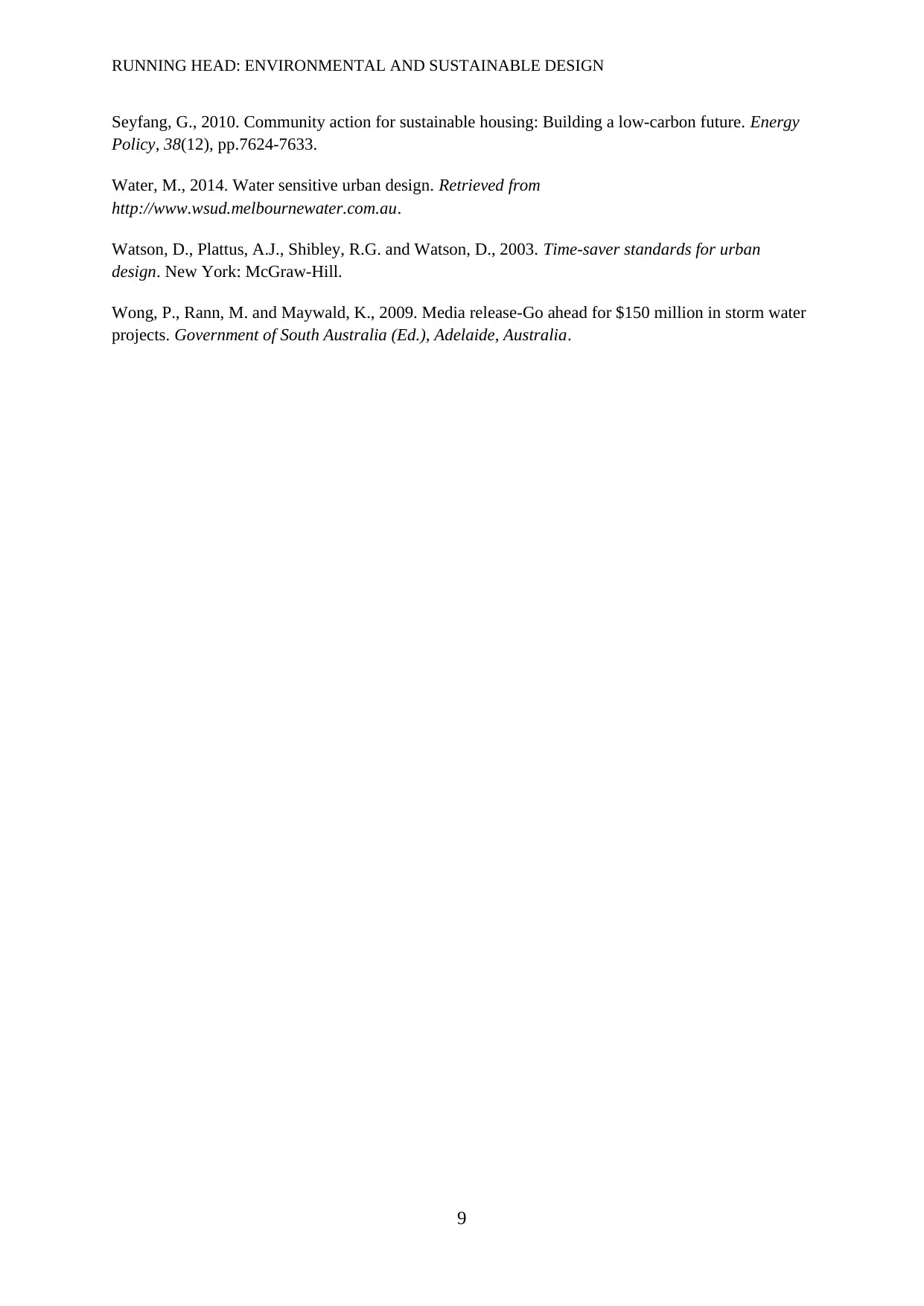
RUNNING HEAD: ENVIRONMENTAL AND SUSTAINABLE DESIGN
Seyfang, G., 2010. Community action for sustainable housing: Building a low-carbon future. Energy
Policy, 38(12), pp.7624-7633.
Water, M., 2014. Water sensitive urban design. Retrieved from
http://www.wsud.melbournewater.com.au.
Watson, D., Plattus, A.J., Shibley, R.G. and Watson, D., 2003. Time-saver standards for urban
design. New York: McGraw-Hill.
Wong, P., Rann, M. and Maywald, K., 2009. Media release-Go ahead for $150 million in storm water
projects. Government of South Australia (Ed.), Adelaide, Australia.
9
Seyfang, G., 2010. Community action for sustainable housing: Building a low-carbon future. Energy
Policy, 38(12), pp.7624-7633.
Water, M., 2014. Water sensitive urban design. Retrieved from
http://www.wsud.melbournewater.com.au.
Watson, D., Plattus, A.J., Shibley, R.G. and Watson, D., 2003. Time-saver standards for urban
design. New York: McGraw-Hill.
Wong, P., Rann, M. and Maywald, K., 2009. Media release-Go ahead for $150 million in storm water
projects. Government of South Australia (Ed.), Adelaide, Australia.
9
⊘ This is a preview!⊘
Do you want full access?
Subscribe today to unlock all pages.

Trusted by 1+ million students worldwide
1 out of 12
Related Documents
Your All-in-One AI-Powered Toolkit for Academic Success.
+13062052269
info@desklib.com
Available 24*7 on WhatsApp / Email
![[object Object]](/_next/static/media/star-bottom.7253800d.svg)
Unlock your academic potential
Copyright © 2020–2025 A2Z Services. All Rights Reserved. Developed and managed by ZUCOL.





